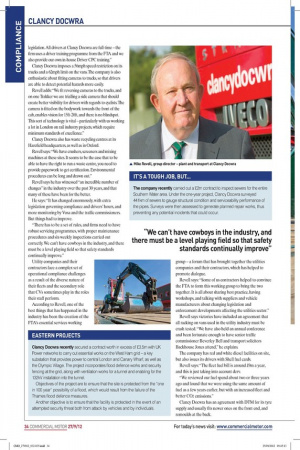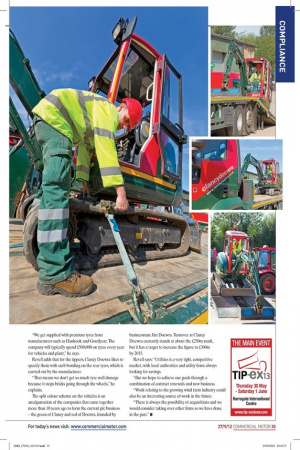On solid foundations
Page 23

Page 25

Page 26

If you've noticed an error in this article please click here to report it so we can fix it.
From humble origins, Clancy Docwra has grown into a well-known and respected name providing services to utility companies
Words: Roger Brown / Images: Tom Lee Clancy Docwra has gone from strength to strength since Michael Clancy started the business with a solitary wheelbarrow from a yard in Wembley more than 50 years ago. The company is now based at a leafy site in Hareield, Middlesex, close to the M25, and has ive other bases across the country.
The sites provide services for high-proile water irms such as (Anglian Water, Mid Kent Water, Scottish Water, Southern Water, Sutton and East Surrey Water and Thames Water), as well as electricity irms including Scottish Power.
Mike Revell, group director of plant and transport at Clancy Docwra, who joined the company 28 years ago, says the key to the irm’s growth has been its ability to provide customers with excellent service.
He tells CM: “There is a large mix of trailers and trucks as well as plant and machinery in our leet, and about 65% of our business is related to water utilities. We pride ourselves on offering a top-quality service to all our customers and believe this is what has kept us at the forefront of the industry for so long.” Clancy Docwra operates about 180 LGVs, 900 vans and 200 car-derived vans. The majority of the trucks are Ivecos supplied by the Stormont Truck and Van dealership, but the company also runs a handful of Dafs and Volvos. Mainstays of the leet are the Trakker 8x4 and Eurocargo 12-tonner.
Revell says: “We own all the lorries and trailers, and tend to keep them for ive or six years. The company uses an Iveco Stralis for a lot of the heavy haulage work, but also a Volvo for the big stuff in conjunction with a Nooteboom trailer. We also run Andover Trailers to carry items like pipes.” All vehicles are serviced at the company’s workshops in Dartford, Hareield, Livingston and Sunderland. Some of the mechanics work speciically on the heavy equipment, others on the lighter vehicles and there is also a pool of mobile mechanics.
New projects
The irm is building a new paint shop and renovating its preparation bay at Hareield.
Revell says: “We have a rolling road brake test facility and MoTs are carried out on vehicles up to Class Seven. I have a good relationship with the team at Stormont and back-up is good. The engine on the Trakker is reliable and the drivers think that the semi-automatic gearboxes are good.” Tippers designed to carry spoil, aggregates, rubble, soil and waste are itted with bodies from Shefield-based specialist Massey Truck Engineering. There are more than 60 trailer-mounted grab cranes in the leet, from Epsilon and HMF.
All lorries are itted with Iveco’s own tracking system – also called Trakker – which is able to monitor unwanted driver behaviour such as harsh braking and idling.
Revell is a big fan of the Van Excellence scheme – which promotes best practice among van operators – and believes the concept should be extended to trucks.
“We ind that updates from the Freight Transport Association [FTA] also help us to keep abreast of changes in legislation. All drivers at Clancy Docwra are full-time – the irm uses a driver training programme from the FTA and we also provide our own in-house Driver CPC training.” Clancy Docwra imposes a 56mph speed restriction on its trucks and a 62mph limit on the vans. The company is also enthusiastic about itting cameras to trucks, so that drivers are able to detect potential hazards more easily.
Revell adds: “We it reversing cameras to the trucks, and on one Trakker we are trialling a side camera that should create better visibility for drivers with regards to cyclists. The camera is itted on the bodywork towards the front of the cab, enables vision for 15ft-20ft, and there is no blindspot. This sort of technology is vital – particularly with us working a lot in London on rail industry projects, which require minimum standards of excellence.” Clancy Docwra also has waste recycling centres at its Hareield headquarters, as well as in Oxford.
Revell says: “We have crushers, screeners and mixing machines at these sites. It seems to be the case that to be able to have the right to run a waste centre, you need to provide paperwork to get certiication. Environmental procedures can be long and drawn out.” Revell says he has witnessed “an incredible number of changes” in the industry over the past 30 years, and that many of these have been for the better.
He says: “It has changed enormously, with extra legislation governing compliance and drivers’ hours, and more monitoring by Vosa and the trafic commissioners. But things had to improve.
“There has to be a set of rules, and irms need to have robust servicing programmes, with proper maintenance procedures and six-weekly inspections carried out correctly. We can’t have cowboys in the industry, and there must be a level playing ield so that safety standards continually improve.” Utility companies and their contractors face a complex set of operational compliance challenges as a result of the diverse nature of their leets and the secondary role that CVs sometimes play in the roles their staff perform.
According to Revell, one of the best things that has happened in the industry has been the creation of the FTA’s essential services working group – a forum that has brought together the utilities companies and their contractors, which has helped to promote dialogue.
Revell says: “Some of us contractors helped to convince the FTA to form this working group to bring the two together. It is all about sharing best practice, having workshops, and talking with suppliers and vehicle manufacturers about changing legislation and enforcement developments affecting the utilities sector.” Revell says victories have included an agreement that all racking on vans used in the utility industry must be crash tested. “We have also held an annual conference and been fortunate enough to have senior trafic commissioner Beverley Bell and transport solicitors Backhouse Jones attend,” he explains.
The company has red and white diesel facilities on site, but also issues its drivers with Shell fuel cards.
Revell says: “The leet fuel bill is around £9m a year, and this is just taking into account derv.
“We reviewed our fuel spend about two or three years ago and found that we were using the same amount of fuel as a few years earlier, but with an increased leet and better CO2 emissions.”
Clancy Docwra has an agreement with DTM for its tyre supply and usually its newer ones on the front end, and remoulds at the back. “We get supplied with premium tyres from manufacturers such as Hankook and Goodyear. The company will typically spend £500,000 on tyres every year for vehicles and plant,” he says.
Revell adds that for the tippers, Clancy Docwra likes to specify them with curb bonding on the rear tyres, which is carried out by the manufacturer.
“That means we don’t get so-much tyre wall damage because it stops bricks going through the wheels,” he explains.
The split colour scheme on the vehicles is an amalgamation of the companies that came together more than 10 years ago to form the current plc business – the green of Clancy and red of Docwra, founded by businessman Jim Docwra. Turnover at Clancy Docwra currently stands at about the £250m mark, but it has a target to increase the igure to £300m by 2015.
Revell says: “Utilities is a very tight, competitive market, with local authorities and utility irms always looking for savings.
“But we hope to achieve our goals through a combination of contract renewals and new business.
“Work relating to the growing wind farm industry could also be an interesting source of work in the future.
“There is always the possibility of acquisitions and we would consider taking over other irms as we have done in the past.” ■
EASTERN PROJECTS
Clancy Docwra recently secured a contract worth in excess of £3.5m with UK Power networks to carry out essential works on the West Ham grid – a key substation that provides power to central London and Canary Wharf, as well as the Olympic Village. The project incorporates flood defence works and security fencing at the grid, along with ventilation works for a tunnel and enabling for the 132kV installation into the tunnel.
Objectives of the project are to ensure that the site is protected from the “one in 100 year” possibility of a flood, which would result from the failure of the Thames flood defence measures.
Another objective is to ensure that the facility is protected in the event of an attempted security threat both from attack by vehicles and by individuals.
IT’S A TOUGH JOB, BUT...
The company recently carried out a £2m contract to inspect sewers for the entire Southern Water area. Under the one-year project, Clancy Docwra surveyed 441km of sewers to gauge structural condition and serviceability performance of the pipes. Surveys were then assessed to generate planned repair works, thus preventing any potential incidents that could occur.










































